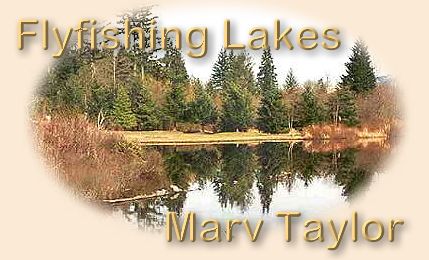|
There were a dozen float tubers working the
northern bay at Nevada's Sheep Creek Reservoir
that autumn morning several years ago, and while
most had gone fishless, one angler had routinely
been catching trout. So many trout, in fact, that
he had the other tubers talking to themselves.
I watched this obviously skilled fly fisherman closely.
The first thing I noticed was his patience. Working
pockets in the bay, the angler would cast, lift his
rod high and use a reverse "Leisenring Lift". He
would count to 15 as he slowly dropped the rod tip
to the surface (I timed the sequence).
If he hadn't made contact with a fish at that point,
he would begin a very slow hand-twist retrieve until
he either hooked a fish, or his fly snagged in the
few weeds that remained in the lake. If it didn't
release easily, he would jerk it free, retrieve quickly,
clean it off, and cast to another spot, repeating the
process.
When I finally got a chance to talk with the angler,
I didn't need to ask what kind of fly he was fishing,
only the precise pattern. I've fished snail flies
long enough to recognize another snail fisherman and
I was curious to see if we had similar patterns. It
turned out that he had read a newspaper column I had
done on using variegated chenilles for snail patterns,
and our snail boxes looked as if they had come out of
the same catalog.
Certain patterns, backswimmer and snail flies, for
example, can be a great deal more effective in early
spring, and late fall, when the weed beds are much
less dominant. With less cover to protect them, these
aquatic life forms are much easier to capture by
foraging trout.
My favorite snail pattern is actually a combination
scud/snail fly. It started out as a very successful
shrimp (scud) pattern, but because of its chunky overall
shape has also been my most productive snail fly in recent
years.
The evolution of this pattern took place over a number
of years. With the acquisition of a wide variety of new
variegated chenilles (more than one color in the chenille),
I narrowed the most useful color combinations to what I
call my "big eight" (listed later in the column).
I tried the gold/dark olive combination in several of
nondescript chenille-bodied patterns, such as the Tex
Favorite and Sheep Creek Special, and found it actually
improved their over-all effectiveness. The standard Tex
became a light olive Tex and finally evolved to the
Taylor Shrimp. The pattern is now a solid member of my
DEADLY DOZEN.
While the commonly used animal and synthetic dubbing
materials construct effective nymph and wet fly bodies,
the variegated chenilles give the tier another option
he/or she should consider. Variegation can create the
illusion of depth better than most other materials
because it is less opaque than solid colors; and because
most aquatic life forms are also multicolored. It is my
opinion that this "depth" is the primary reason these
variegated chenille flies work so well. Almost any fly
pattern that utilizes chenille can be improved when the
tier uses these multicolored chenilles instead of solid
colors.
The ubiquitous Woolly Worms and Woolly Buggers are prime
examples. These flies can be dressed in any of the
variegated colors. My favorite color combinations
include: Black and brown; Brown and gray; Peacock
and brown; Gold and dark olive; Olive and grey; Black
and tan; Black and orange; and Black and burnt orange.
By using different colored hackles, the tier can
considerably broaden his Woolly Worm and Woolly Bugger
assortments.
The angler who has his own ideas about variegated
chenilles, can order any colors the manufacturer
(Danville) makes, blended into any of the sizes
they make (except 00). He must, however, place an
order through his favorite materials department for
five skeins of each size he needs (that's enough
chenille for about 10 life times. He will need a
few buddies to share with).
That brings me to the question of chenille sizes.
Although Danville lists their sizes from #00 (the
smallest) to #4 and #5 (the largest), for our
urposes we will consider only sizes #00 to #2.
When the tier buys chenille in a fly shop, he
will usually find them marked small, medium,
and large. Small will usually mean either #00
or #0; medium either #1 or #2; and large number #3
or #4. (Fly tying materials distributors seem to
arbitrarily decide their medium is Danville's
#1 or #2. My primary distributor uses #1 as medium;
most other distributors I've dealt with use #2).
I have a tendency in my tying to use smaller chenilles
than most tiers. I believe a key to a good fly pattern
usually leans towards "sparseness." On size 6 and 8
bugger (type) patterns, I use #1 chenille. On my 10s
and 12s, I use #0 chenille, and on my 14s and 16s, I
use #00 (available in only solid colors. If the pattern
I'm tying in size 16, for example, requires one of the
variegated chenilles, I use size 0 and trim it). If I
have any doubts about which chenille to use, I go with
the smaller size.
I've gone through several phases in my stillwater fly
fishing/tying career. The first several years I used
chenille and saddle hackle almost exclusively. I used
only the solid colored chenilles, usually in (Danville's)
size 2. Then I "discovered" animal furs (muskrat, beaver,
otter etc.) and mohair, and pretty much strayed away
from chenille for a number of years.
When the late Ruel Stayner began selling the variegated
chenilles in his Twin Falls, Idaho fly shop, I tried
them with a great deal of success. I remained loyal
to the mohairs, particularly the legendary Canadian
Brown, Blood, and Olive series, but I now began to
tie more and more of my wet flies with several of
the variegated chenilles instead of fur.
In his book Naturals, Stackpole Books,
1980, Gary Borger writes:
"Leeches are every color of
the artist's pallet. As a rule they are spotted,
mottled, streaked, or striped, often in reds, oranges,
and yellows. The background color is usually gray,
brownish, olive or black."
Are the variegated chenilles useful in tying leech
patterns? Does a bear sleep in the woods?
I also successfully switched many of my fur-bodied
caddis pupas to variegated chenilles.
If the manufacturers of chenille would blend their
size #00, I would also switch many of my medium-sized
chrironomid patterns (sizes 12 through 16) to chenille.
I receive letters and e-mails all the time, remarking
how simple most of my stillwater patterns are. I usually
respond by telling them: Simple flies from simple people.
(Wow! I've left myself open there, haven't I?)
~ Marv
About Marv
Marv Taylor's books, Float-Tubing The West,
The Successful Angler's Journal,
More Fragments of the Puzzle, (Volume I) and More
Fragments of the Puzzle, (Volume II) are all available from
Marv. You can reach Marv by email at
marvtroutman@juno.com or by phone: 208-322-5760.
|


